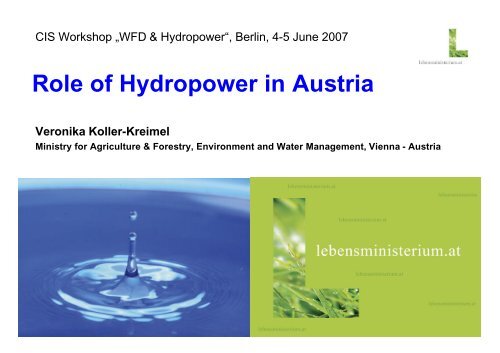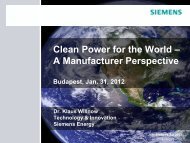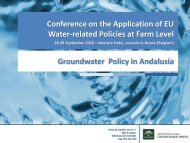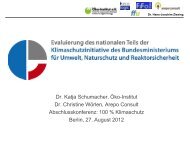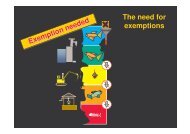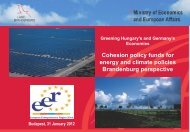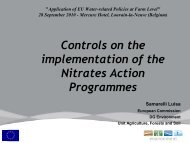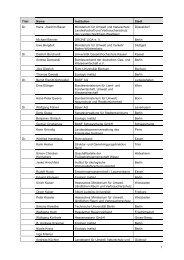Role of Hydropower in Austria - Events
Role of Hydropower in Austria - Events
Role of Hydropower in Austria - Events
Create successful ePaper yourself
Turn your PDF publications into a flip-book with our unique Google optimized e-Paper software.
CIS Workshop „WFD & <strong>Hydropower</strong>“, Berl<strong>in</strong>, 4-5 June 2007<br />
<strong>Role</strong> <strong>of</strong> <strong>Hydropower</strong> <strong>in</strong> <strong>Austria</strong><br />
Veronika Koller-Kreimel<br />
M<strong>in</strong>istry for Agriculture & Forestry, Environment and Water Management, Vienna - <strong>Austria</strong><br />
Hier steht e<strong>in</strong> thematisches Foto<br />
Seite 1 06.06.2007
Ma<strong>in</strong> characteristics:<br />
- alp<strong>in</strong>e (precipitation, <strong>in</strong>cl<strong>in</strong>e)<br />
- primary energy resource:<br />
no oil, gas or coal -<br />
only hydropower (renewable!)<br />
- <strong>in</strong>land country<br />
(high transport prices)<br />
Seite 2<br />
CIS-WS „WFD & <strong>Hydropower</strong>“, Berl<strong>in</strong> , 4-5 June 2007<br />
<strong>Austria</strong>/ Koller-Kreimel, BMLFUW
Electricity generation <strong>in</strong> <strong>Austria</strong><br />
About 2/3 is generated by hydropower.<br />
S<strong>in</strong>ce 2002 the proportion <strong>of</strong> hp generation decreased due to higher<br />
consumption, climatic reasons àhigher use <strong>of</strong> caloric generation<br />
Electricity production <strong>in</strong> <strong>Austria</strong> 2004<br />
total generation 2004: 64.000 GWh<br />
hydropower<br />
generation<br />
others*<br />
39,0%<br />
large hp<br />
54,5%<br />
large hp<br />
small hp<br />
others<br />
‣ base load<br />
‣ peak load<br />
‣ ancillary services<br />
6,5%<br />
small hp<br />
source: E-control<br />
*caloric, w<strong>in</strong>d, solar, etc.<br />
hp……….. hydropower<br />
Seite 3<br />
CIS-WS „WFD & <strong>Hydropower</strong>“, Berl<strong>in</strong> , 4-5 June 2007<br />
<strong>Austria</strong>/ Koller-Kreimel, BMLFUW
Structure <strong>of</strong> hydropower generation <strong>in</strong> <strong>Austria</strong><br />
maximum<br />
capacity<br />
No <strong>of</strong><br />
plants<br />
% <strong>of</strong><br />
total No<br />
GWh<br />
% <strong>of</strong><br />
total hp gen<br />
small<br />
hydropower<br />
< 200 kW<br />
200 - 500 kW<br />
500 kW–1 MW<br />
1442<br />
292<br />
184<br />
63<br />
13<br />
8<br />
337<br />
385<br />
468<br />
0,8<br />
0,9<br />
1,1<br />
1 – 2 MW<br />
118<br />
5<br />
598<br />
1,4<br />
2 – 5 MW<br />
73<br />
3<br />
745<br />
1,8<br />
5 – 10 MW<br />
34<br />
1<br />
881<br />
2,1<br />
total<br />
2143<br />
93<br />
3414<br />
8,1<br />
large hp<br />
> 10 MW<br />
156<br />
7<br />
38000<br />
91<br />
TOTAL<br />
2299*<br />
100<br />
41000<br />
100<br />
* > 2000 very small plants (only private supply) to be added<br />
storage power plants<br />
run-<strong>of</strong>-river power stations<br />
1 2
<strong>Hydropower</strong> Potential<br />
gross theorethical potential …..150.000 GWh<br />
estimated realistic/feasible potential …. 56.000 - 60.000 GWh<br />
- already used/generated ………….… about 70%<br />
What about the other 30%<br />
• valuable renewable energy<br />
• strict requirement (EU, national goverment) to <strong>in</strong>crease energy<br />
generation from renewables for CO2-reduction<br />
• what does it mean for water ecology (WFD objectives)<br />
Seite 5<br />
CIS-WS „WFD & <strong>Hydropower</strong>“, Berl<strong>in</strong> , 4-5 June 2007<br />
<strong>Austria</strong>/ Koller-Kreimel, BMLFUW
Art. 5 Results - Risk Assessment rivers > 100 km 2<br />
no risk<br />
16%<br />
at risk 60%<br />
24% possibly<br />
at risk<br />
hydropeak<strong>in</strong>g<br />
3.148 migration barriers …...... 1 / 3,5 km<br />
hydropower (1/3)……..…1 / 10 km<br />
575 backwater > 500 m ………...1 / 20 km<br />
• no ecological m<strong>in</strong> flow<br />
(water diversion for HP)….…1 / 16 km<br />
• sections <strong>in</strong>fluenced by hydropeak<strong>in</strong>g<br />
Seite 6<br />
CIS-WS „WFD & <strong>Hydropower</strong>“, Berl<strong>in</strong> , 4-5 June 2007<br />
<strong>Austria</strong>/ Koller-Kreimel, BMLFUW
Outcome <strong>of</strong> the Art. 5 report with respect<br />
to hydropower<br />
‣ restauration measures<br />
have to be carried out<br />
• <strong>in</strong>vestment cost<br />
• reduction/impact on<br />
power generation<br />
‣ to restore cont<strong>in</strong>uity (fish ladders, …)<br />
‣ to provide egological m<strong>in</strong>imum flow<br />
‣ to <strong>in</strong>crease habitat diversity<br />
‣ to m<strong>in</strong>imise water level fluctions<br />
Seite 7<br />
CIS-WS „WFD & <strong>Hydropower</strong>“, Berl<strong>in</strong> , 4-5 June 2007<br />
<strong>Austria</strong>/ Koller-Kreimel, BMLFUW
WFD implications on <strong>Austria</strong>n hydropower<br />
Source: Stigler et al. (2005)<br />
http://gpool.lfrz.at/gpoolexport/media/file/Auswirkungen_WRRL_auf_Wasserkraft-Studie.pdf<br />
restauration <strong>of</strong> river cont<strong>in</strong>uity<br />
Investment costs:<br />
‣ small hydropower………… ca. 90 Mio €<br />
‣ large hydropower……… 60 -144 Mio €<br />
Seite 8<br />
CIS-WS „WFD & <strong>Hydropower</strong>“, Berl<strong>in</strong> , 4-5 June 2007<br />
<strong>Austria</strong>/ Koller-Kreimel, BMLFUW
WFD implications on <strong>Austria</strong>n hydropower<br />
provid<strong>in</strong>g<br />
ecological m<strong>in</strong>imum flow<br />
loss <strong>of</strong> power generation<br />
with respect to<br />
hp sector hp sector total hp generation<br />
f<strong>in</strong>ancial loss<br />
small hp < 10 MW ………. 10 - 32 % * 1,0 - 3,0% 15-50 Mio €/a<br />
large hp > 10 MW….…….... 5 - 20 % 0,4 - 1,5 % 4-16 Mio €/a<br />
storage pp** …..………….2,8 – 10,2 % 0,7 - 2,5 % ** .<br />
total 2,1 – 7 %<br />
** also loss <strong>of</strong> peak load and ancillary services<br />
Remark: „worst case“ estimation<br />
Compensation <strong>of</strong> losses by technical optimisation measures was<br />
not taken account!<br />
Seite 9<br />
CIS-WS „WFD & <strong>Hydropower</strong>“, Berl<strong>in</strong> , 4-5 June 2007<br />
<strong>Austria</strong>/ Koller-Kreimel, BMLFUW
WFD implications on <strong>Austria</strong>n hydropower<br />
Reduction <strong>of</strong> water level fluctuations<br />
‣ build<strong>in</strong>g compensation reservoirs (availability <strong>of</strong> land<br />
‣ transferr<strong>in</strong>g the discharge <strong>in</strong>to a larger river<br />
à <strong>in</strong>vestment costs<br />
‣ chang<strong>in</strong>g the operational mode<br />
à loss <strong>of</strong> ancillary services<br />
à loss <strong>of</strong> peak load<br />
---- extreme f<strong>in</strong>ancial losses!<br />
(example: one company 80 Mio €/a)<br />
Seite 10<br />
CIS-WS „WFD & <strong>Hydropower</strong>“, Berl<strong>in</strong> , 4-5 June 2007<br />
<strong>Austria</strong>/ Koller-Kreimel, BMLFUW
Constra<strong>in</strong>ts to further development <strong>of</strong> hp plants<br />
How to solve the conflict between WFD and CO 2 reduction<br />
‣ large hp: no/low acceptance for new plants by the public;<br />
even there is no specific higher damage <strong>of</strong> water ecology compared to small hp<br />
‣ small hp: <strong>in</strong> additon to the exist<strong>in</strong>g 4200 GWh another 4500 GWh ere<br />
expected to be generated by build<strong>in</strong>g new plants.<br />
Do we expect to build additional 2000 small hp plants lead<strong>in</strong>g to a<br />
high amount <strong>of</strong> impacted water bodies (backwater, reduced cont<strong>in</strong>uity)<br />
+ Result <strong>of</strong> Art.5 report: only few water bodies left with „near natural“ conditions;<br />
there is a specific stress to be used for small hp generation (à plann<strong>in</strong>g <strong>of</strong> „go“<br />
and „no go“ areas<br />
+ How we can ensure that exist<strong>in</strong>g plants are technically optimised /old<br />
structures rebuilt before before build<strong>in</strong>g new plants<br />
Seite 11<br />
CIS-WS „WFD & <strong>Hydropower</strong>“, Berl<strong>in</strong> , 4-5 June 2007<br />
<strong>Austria</strong>/ Koller-Kreimel, BMLFUW


